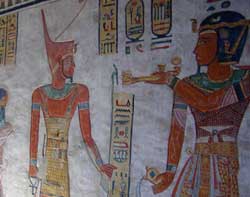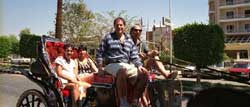|
Luxor
 Luxor
is located 670 km south of Cairo. It is considered as the
greatest outdoor museum in the world as it contains nearly one
third of the world’s antiquities. There is hardly a place in
Luxor which has not a relic that reflects the greatness of the
ancient Egyptians and their civilization that dates back to
seven thousand years ago. Luxor
is located 670 km south of Cairo. It is considered as the
greatest outdoor museum in the world as it contains nearly one
third of the world’s antiquities. There is hardly a place in
Luxor which has not a relic that reflects the greatness of the
ancient Egyptians and their civilization that dates back to
seven thousand years ago.
Luxor is part of the ancient “Thebes” that the renowned Greek
poet Homer describes as “the city of one hundred gates”. It
remained the seat of power from 2100 to 750 BC.
The Arabs called it Luxor meaning the city of Palaces, because
they were impressed by its magnificent edifices and huge
buildings.
Luxor still attracts hordes of visitors, from all over the world
to enjoy the monuments of the eternal city and its temples with
their towering pillars on the two banks of the Nile. The City of
the living on the east bank where sunrise is source of life and
growth and the City of the dead on the West Bank where sunset
symbolizes the eclipse of Life.
On the East Bank stand the Luxor Temple, a graceful ornament on
its waterfront and downtown quarter, while just to the north is
Karnak Temple, a stupendous complex built over 1300 years.
 Across
the river on the West Bank are the amazing tombs and mortuary
temples of the Theban necropolis: the Valley of the Kings, the
valley of the queens, Hatshepsut temple, valley of the artisans,
valley of the nobles and Memnon Colosse Across
the river on the West Bank are the amazing tombs and mortuary
temples of the Theban necropolis: the Valley of the Kings, the
valley of the queens, Hatshepsut temple, valley of the artisans,
valley of the nobles and Memnon Colosse
Recently, a bridge connecting the east and the west banks has
been constructed to speed up tourist traffic to the West Bank.
Luxor also serves as a base for trips to Esna, Edfu, Dendara and
Abydos Temples up and down the Nile valley.
You can enjoy the wonderful tourist sites of Luxor soaring in a
balloon above the temples on the east and west banks which lasts
for one and half hour!
|